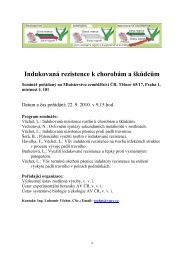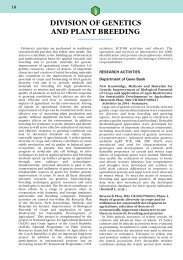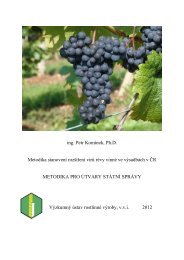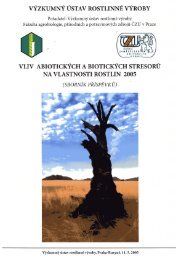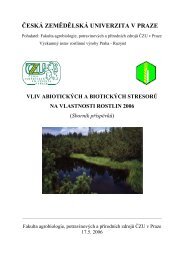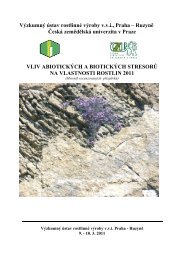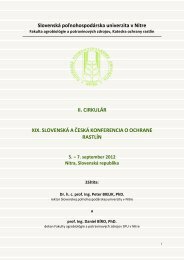00 ZLOM VURV 06 v roce 07
00 ZLOM VURV 06 v roce 07
00 ZLOM VURV 06 v roce 07
Create successful ePaper yourself
Turn your PDF publications into a flip-book with our unique Google optimized e-Paper software.
14<br />
Fig. 1: Crop structure of Czech collections of plant genetic resources<br />
At present, twelve Czech institutions taking part in<br />
the NP hold 50,<strong>00</strong>0 accessions of plant genetic resources.The<br />
crop structure of collections is given in Fig.<br />
1. The NP deals with gathering (including collecting<br />
missions), documentation, characterization, evaluation<br />
and conservation of plant genetic resources and provides<br />
services to users.The Gene Bank in RICP Prague provides<br />
the long-term storage of seed samples (at -18 °C<br />
or -5 °C) for all seed-propagated collections and renders<br />
services of the National Information System on Plant<br />
Genetic Resources (EVIGEZ). All members of the NP<br />
have close partnerships with users within the country<br />
and abroad and supply to them samples of genetic<br />
resources (4-5 thousand accessions yearly) in accordance<br />
with IT PGRFA. International collaboration and effective<br />
cooperative links have been set up especially within<br />
the European Cooperative Programme (ECPGR).<br />
Intensive characterization and evaluation of genetic<br />
resources are carried out to support their use in breeding<br />
and in agricultural practice. Collecting missions as<br />
well as conservation and surveys of valuable resources<br />
conserved “in situ” contribute to the preservation and<br />
evaluation of local resources.“On farm” conservation is<br />
being developed in landraces of fruit trees and some<br />
other crops. Cultivars and landraces of neglected crops<br />
(buckwheat, millet, hulled wheat species, some fruit trees<br />
and forage crops) were successfully used for agro- biodiversity<br />
enrichment;their specific use especially in human<br />
nutrition is also important. Close collaboration with<br />
producers (often organic farmers) and p<strong>roce</strong>ssing industry<br />
was set up.We also studied selected alternative crops<br />
and catch crops with the aim to introduce them into<br />
growing and contribute to the soil fertility improvement.<br />
Recently, detailed inventory was carried out and<br />
current data were complemented by newly acquired<br />
information, including data on the viability and<br />
accessibility of accessions and regeneration needs.<br />
Among all accessions 74% are freely available, while<br />
other 18.4% are accessible under particular conditions<br />
and 5.7% need urgent regeneration.The accessibility of<br />
generatively reproduced genetic resources is higher<br />
(78.8 %) than that of vegetatively propagated ones<br />
(54.3 %). Steps have been taken to reduce threats to<br />
plant genetic resources, to increase their safety and<br />
measures were suggested how to improve access to<br />
plant genetic resources (including prompt and suitable<br />
regeneration, safe conservation and effective evaluation<br />
and documentation):<br />
• Sufficient and stable funding of NP<br />
• Support to research projects linked to the NP,<br />
further studies and use of genetic resources and<br />
agro-biodiversity for sustainable development;<br />
systematic transfer of valuable materials and data<br />
from research projects into NP<br />
• Better management and use of collected materials<br />
• Speed up regeneration where needed<br />
• Better control and monitoring of the health status<br />
of plant genetic resources<br />
• Extension of evaluation and characterization, broad<br />
and effective implementation of new technologies<br />
• Wider international cooperation and support to<br />
the exchange of genetic resources and information<br />
• Increase in the public awareness of genetic resources<br />
and biodiversity<br />
Gene Bank Storage<br />
At the end of 2<strong>00</strong>6, the gene bank storage reached<br />
37,211 accessions which were kept under long-term or<br />
medium-term conditions. It represents more than 93%




